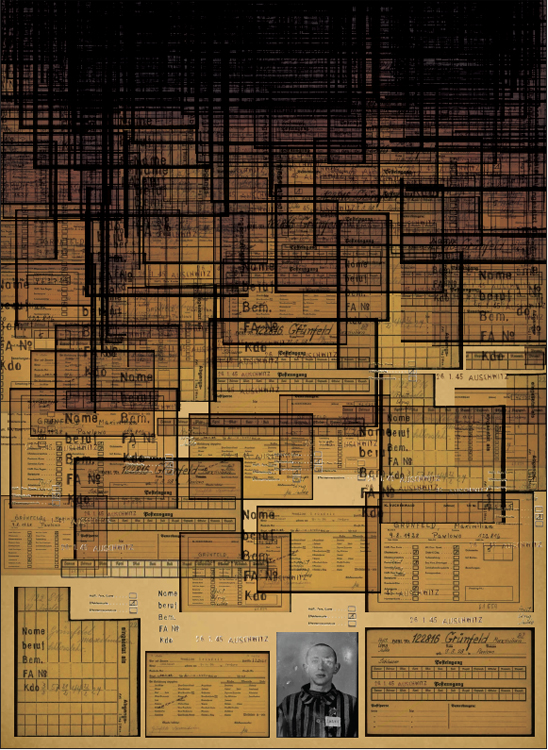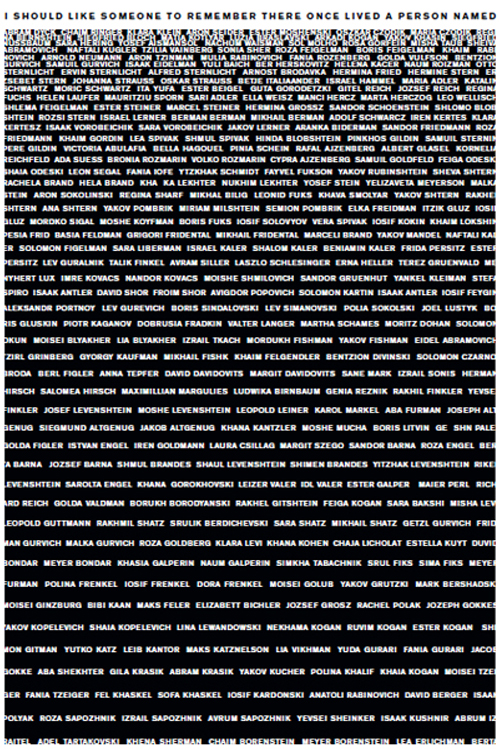Caitlin McGinn (Canada), Carling Hind (Canada) and James Alonso (United Kingdom) are the three finalists of the International Holocaust Poster competition 2014, a joint project of Yad Vashem and the Holocaust and the United Nations Outreach Programme.
Introduction
Posters remain a ubiquitous and accessible art form for catching our attention - appearing in multiples, covering public surfaces, visible to all. They draw attention to an event, political message or product, which may change or be gone in the following days or weeks. They offer fresh perspectives on old themes. It is the innate capacity of the poster to reflect the here and now which makes them such a current, arresting and succinct visual medium. For this reason, poster art is the focus of the "Keeping The Memory Alive" competition, now for the second cycle "Journeys Through The Holocaust", bringing international partners and designers from countries across the world together in a shared endeavor of designing memory to inspire current and future generations.
Posters offer an excellent gateway to help educators convey the complexities of memory and commemoration to students. Through displaying and teaching with the set of posters, educators and students the world over can discuss the individual messages that these international designers convey in their works. For this reason, Yad Vashem educators have also created a complementary lesson plan based on the 2014 display.
Three Winning Posters
The three finalists in the international Holocaust poster competition were selected by the prestigious jury of artists and Holocaust Educators from across the world. All three posters are visually striking, and can be seen to stand out for their complexity and meanings. All three designers further note that their knowledge of the Holocaust was limited to learning in School, and as they grew older, through film, drama and television. Yet all three have created powerful works, which have resonated with Holocaust educators and which will be used as accessible tools with which to teach the Holocaust by teachers in schools all over the world.
Canadian designer Caitlin McGinn created the winning design, selected from hundreds. Caitlin, a student at Emily Carr University, Vancouver, was inspired to depict the bureaucratic journey through the Holocaust meticulously documented by history. "These bits of paper give us tiny glimpses into the lives of individuals who may no longer have a voice to tell their own story", she explains. On viewing her piece, the effect is simple yet stunning: "As the infinite documents tumble from the top of the poster, they are slowly sorted through until one person's story is revealed. The documents help to tell the story of their life inside the camp: a work card documenting their forced labour, the list of personal effects they had when they were transferred between labour camps, an identification photograph highlighting their prisoner number, and the card used to track their incoming and outgoing mail. In a time when voices were silenced and lives were ended, each of these surviving documents helps family, friends, historians and scholars piece together each distinct story." In designing her poster, Caitlin drew inspiration from the Yad Vashem museum archives. As witnessed by the multitude of documents and the picture of the individual "concluding" the poster, Caitlin maintains that "the ultimate purpose of both scholarly research and family archives is to tell the stories of individuals, cultures, and nations. Through these stories, we develop empathy for others, learn more about ourselves and help influence our future." Indeed, reflecting on the immense bureaucracy required to implement the Shoah across Europe from the outset remains a crucial keystone in comprehensive Holocaust education. As such, this poster will serve as an invaluable tool for educators in disseminating this message, reflecting the magnitude through the individual.
Fellow Canadian (and Emily Carr University student) Carling Hind's piece- awarded the second prize- is also a study in multiplicity, yet in a very different, no less effective, direction. Hind claimed inspiration for her poster from the Shoah Names Database on the Yad Vashem website, and from the individual stories and notes to be found there. One specifically was a note that read: "I should like someone to remember that there once lived a person named David Berger." David in his last letter, Vilna 1941 Hind recounts: "What particularly struck me about this note was the fact there were so many individuals within the masses who lost their identities during the Holocaust, and that in turn, we lost." As such, her poster was created to be "a type of monument - I could do an entire exhibition designing the “art of these names,” and honoring them as such. The contrast of white on black exemplifies the drama, the tightened ledding and tracking of the type at the top almost mirrors the sense of urgency (whether it was to get onto a train, or the urgency to be remembered), and as the names loosen and space out more and more it just leaves room for so many more names. The list is ongoing, and the journey to recover them helps us honor the entire lives of these people."
It can be seen that modern teaching of the Holocaust places great emphasis on the story of the individual, as through those stories we can unlock personal connections and empathy with history, and a willingness to learn more through such connections. Much like through the evolution of the individual through graphic tapestry of Caitlin McGinn's poster, the solitary stance of the individual resonates throughout Carling Hind's gently haunting work. In Hind's own words: "The message I would like to impart on others, is to never lose sight of the individual (whether yourself or while addressing a group); everyone has a story, a history, a name, that was given to them." Hind also recalls the responses that she has received to her powerful work, in particular a comment from someone closely affected by the Holocaust, who told her. "You can know that your work is effective when you are able to take where you've come from [i.e. not directly affected at all by the Holocaust] and yet speak so closely to me." This design experience for "Keeping The Memory Alive", Hind says, has been more profound and overwhelming than any other project she has undertaken.
Finally, James Alonso's piece attempts to examine the experience of the journey through the Holocaust to survival and the return to life. With stark and bold lines and a powerful, considered use of colour, the British designer's poster took 3rd place in the competition. Alonso cites learning about Holocaust survivor Otto Deutsch's experiences, "and the journey he makes", as his prime inspiration. "I tried to create a piece that was almost minimalist, yet offers a variety of possible interpretations that looks at the positive and negative aspects" Alonso says."For example, the tracks can symbolise the journey people were forced to make to camps, yet as the beginning and end of the train tracks cannot be seen it represents continuity… also a train can only go where it's tracks take it, so I made the menorah [Jewish ritual candleholder] apart of the tracks to represent that many Jewish people didn't have a choice about the path they took but returning to the idea of continuity, there are people like Otto Deutsch who shares his story and it moves people and it keeps the memory alive exactly as this competition is also designed to do." Alonso notes that meeting with a survivor and hearing his stories one-on-one was an invaluable and memorable experience, providing a human face to the facts and figures learned at school over a decade ago. This is witnessed in the creation of such a poignant piece.
Alonso further explains his graphic inspiration that "as in typography, the bold line can be used to represent strength, I made the menorah bolder than the sleepers in the track to represent the sort of strength of spirit I can only imagine the survivors and relatives who lost loved ones must have required to overcome and to deal with what was happening around them. I opted for a minimalist approach as I thought the negative/empty would best communicate a poignant tone." Like Hind and McGinn, Alonso has expressed hope that his work will encourage those who view it to question their perceptions of the Holocaust, and maybe inspire them to search further in their learning about it.
In engaging students from around the world in designing creative ways to keep the memory alive, this competition serves its purpose, with the production of these striking pieces of art, which will pack a visual punch to thousands as almost a welcome side effect. Perhaps this is best summed up by winner Caitlin McGinn: "Creating this piece and having the opportunity to engage with Holocaust experts from around the world has taught me that the purpose of reflecting on the Holocaust is to not just look back at history, but also to look forward to the future. Through research, story-telling and remembrance, we learn how to prevent future atrocities, as well as provide aid where the atrocities are currently being committed."









